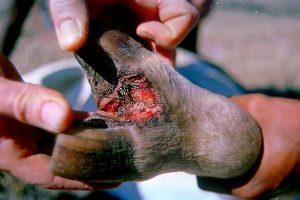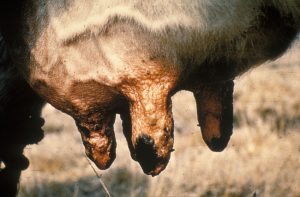FMD , Foot and mouth disease

Foot and mouth disease or hoof and mouth disease is an infectious and viral disease that effects the cloven footed animals having two digits of hooves. Solipers have single digits.FMD is characterized by fever, vesicles on foot, mouth and also sometime on udder.
Other names of FMD:
FMD is also called as hoof and mouth disease, aphthous fever.
Etiology of FMD:
virus is called as foot and mouth disease virus or afthous virus belongs to family PICORNAVIRIDAE. This virus has 7 immunological serotypes. FMD virus is single stranded RNA virus, This virus sometime killed by increasing PH or extreme low PH below 6.5 or above 11.This virus is also inactivated at high temperature. This virus survives at in milk, milk products, bone marrow and lymph nodes. More than 60 sub types exists and their is continuous mutation.
Economic importance of FMD virus:
Most economically devastating disease. Direct loss includes , less production of animals and less milk yield because of lesion in mouth. Recovered animal cannot reach maximum development. Indirect loss due to export shut down and consumer fear.
Epidemiology:
It is an endemic disease most present in winter season. Australia , new Zealand Japan are free from FMD. Mortality is less than 2% in adult but highly contagious and transmissible in young calves 20% because of myocardial necrosis. Morbidity is 100%.
Transmission:
Virus is transmitted by inhalation or ingestion. Virus travel through air up to 250 km. This virus suvives 1-2 days in human respiratory tract. Transmitted by direct and indirect way.
Pathogenesis :
Virus reside in sub epidermal site. Animal ingest the virus attach to the mucosal epithelial cells , penetrate into the cytoplasm , multiply in cell cytoplasm until cell destroyed. More particles release and effect surrounding cells, macrophages and drain into the lymphatic blood system. Gross lesions in area subjected to physiological condition or mechanical trauma. Incubation period is 1-21 days usually 3-8 days in most species. Severe lameness and mastitis and in young animals narcotizing myocarditis.
Clinical signs of FMD:
Incubation period is about 1-21 days, fever and vesicles on feet , mouth muzzle and sometime on udder progress to erosion. Oral cavity hyperemic at start than vesicles on gums , soft palate and hard palate. inter digital spaces vesicles develop. high fever lead to abortion.

Lesions in mouth lead to droopy salivation that is in the form of strings. Serous nasal discharge. Hoof lesions .Mostly lesions on tip of teat.

Sequale of Foot and mouth disease:
Hairy panters , it is the chronic syndrome of dyspnea , over growth of hairs and heat intolerance due to damage to endocrine glands.
Post mortem lesions:
- Tiger heart, Dry lesions, single or multiple vesicles, Red erosion or fibrous coating.
